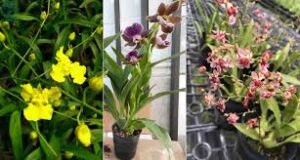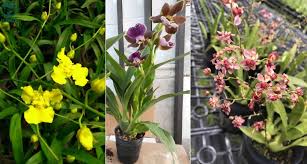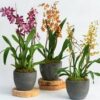# How to Ensure Oncidium Orchids Bloom Simultaneously for Events

Oncidium orchids, also known as “Dancing Lady Orchids,” are renowned for their vibrant colors, unique shapes, and delicate fragrances. They are often used in floral arrangements for various events, including weddings, corporate functions, and festive celebrations. However, to achieve a stunning display, it is essential to ensure that these orchids bloom simultaneously. This article will explore various methods to promote synchronized blooming of Oncidium orchids, focusing on factors such as cultivation practices, environmental conditions, and care techniques. By following these guidelines, you can create a breathtaking display of blooms for your special occasions.
## 1. Understanding Oncidium Orchids
### 1.1 Characteristics of Oncidium Orchids
Oncidium orchids belong to the Orchidaceae family and are known for their unique flower structures and a wide range of colors. Key characteristics include:
– **Diversity**: Oncidium encompasses over 100 species and numerous hybrids, providing various options for growers.
– **Growth Habit**: These orchids can be epiphytic, growing on trees or other plants, or terrestrial, growing in soil.
– **Flowering Season**: Oncidium orchids typically bloom during late summer and fall, making them popular for autumn events.
### 1.2 Importance of Synchronized Blooming
For events such as weddings, exhibitions, or corporate gatherings, having Oncidium orchids bloom simultaneously enhances the visual impact of floral displays. Synchronized blooming creates a cohesive and striking appearance, making it crucial for event planners and florists.
## 2. Factors Influencing Orchid Blooming
### 2.1 Environmental Conditions
Creating the right environment is vital for promoting synchronized blooming in Oncidium orchids. Several environmental factors significantly influence the blooming process:
– **Temperature**: Oncidium orchids thrive in temperatures between 65°F to 80°F (18°C to 27°C) during the day and slightly cooler at night. Maintaining consistent temperatures helps trigger blooming.
– **Light**: Adequate light is essential for photosynthesis and healthy growth. Oncidium orchids prefer bright, indirect light, making them suitable for windowsills or greenhouses.
– **Humidity**: Oncidium orchids require humidity levels between 40% to 70%. Increased humidity can stimulate blooming, so using humidifiers or placing water trays near the orchids can be beneficial.
### 2.2 Watering and Nutrition
Proper watering and nutrition play critical roles in orchid health and blooming:
– **Watering**: Oncidium orchids prefer to dry out slightly between waterings. Overwatering can lead to root rot, while underwatering can stress the plant. Watering should be adjusted based on the environment, with more frequent watering in warmer months.
– **Fertilization**: Providing the right nutrients is crucial for promoting blooming. Use a balanced, water-soluble orchid fertilizer during the growing season, typically diluted to half the recommended strength. Fertilizing every two weeks encourages healthy growth and flowering.
### 2.3 Potting and Growing Medium
The potting and growing medium also influence the blooming process:
– **Potting**: Use pots with drainage holes to prevent water accumulation. Repotting every one to two years ensures that the orchids have fresh growing medium and enough space for root development.
– **Growing Medium**: Oncidium orchids thrive in well-draining potting mixes, such as a blend of bark, sphagnum moss, and perlite. This combination allows for good aeration and moisture retention.
## 3. Promoting Synchronized Blooming
### 3.1 Selecting the Right Varieties
To achieve synchronized blooming, consider the following when selecting Oncidium orchids:
– **Choose Similar Varieties**: When planning for an event, select Oncidium orchids of similar varieties, as they are more likely to bloom at the same time. For example, hybrids with similar genetic backgrounds often have comparable blooming cycles.
– **Consider Flowering Season**: Pay attention to the flowering season of each variety. By selecting varieties that bloom simultaneously, you can ensure a cohesive display.
### 3.2 Pre-Event Care and Preparation
To promote synchronized blooming, careful preparation before the event is essential:
– **Timing**: Begin preparing the orchids several months in advance of the event. This allows time for adjustments in care and environmental conditions.
– **Manipulate Light**: Gradually increase the amount of light the orchids receive in the weeks leading up to the event. This can help stimulate blooming. Consider using grow lights if natural light is insufficient.
– **Temperature Adjustment**: Manipulating temperatures can also encourage blooming. Gradually lower nighttime temperatures by a few degrees, as this can mimic the natural conditions that trigger flowering.
### 3.3 Watering and Nutrient Management
Adjusting watering and nutrient management can influence the timing of blooming:
– **Watering Schedule**: Develop a consistent watering schedule in the weeks leading up to the event. Ensuring that orchids receive adequate water without becoming overly saturated can promote healthy blooms.
– **Nutrient Boost**: In the weeks leading up to the event, consider using a bloom-boosting fertilizer high in phosphorus. This nutrient promotes flowering and can help synchronize blooming across multiple plants.
## 4. Strategies for Event Preparation
### 4.1 Transporting Orchids
When transporting Oncidium orchids to an event venue, careful handling is essential:
– **Packaging**: Use sturdy boxes or containers to protect the orchids during transport. Ensure that the orchids are secured to prevent movement and damage.
– **Temperature Control**: Maintain appropriate temperatures during transport. Avoid exposing orchids to extreme heat or cold, as this can stress the plants and affect blooming.
### 4.2 Arranging Orchids for Display
Once the orchids arrive at the event venue, proper arranging is crucial for maximizing their visual impact:
– **Grouping**: Group orchids of the same variety together to create a cohesive look. Consider varying the heights of the arrangements for visual interest.
– **Complementary Elements**: Incorporate complementary elements such as foliage, decorative stones, or other flowers to enhance the overall arrangement. This adds depth and dimension to the display.
## 5. Troubleshooting Common Issues
### 5.1 Delayed Blooming
If your Oncidium orchids are not blooming as expected, consider the following troubleshooting tips:
– **Check Environmental Conditions**: Ensure that the temperature, light, and humidity levels are within the optimal range. Adjustments may be necessary to stimulate blooming.
– **Assess Watering Practices**: Evaluate your watering practices. Overwatering or underwatering can stress orchids and delay blooming.
– **Nutrient Deficiency**: Check for signs of nutrient deficiency, such as yellowing leaves. Adjust fertilization as needed to promote healthy growth and blooming.
### 5.2 Pest Management
Pests can negatively impact orchid health and blooming. Common pests include:
– **Aphids**: Small, soft-bodied insects that can damage plant tissues. Regularly inspect your orchids and treat infestations with insecticidal soap or neem oil.
– **Mealybugs**: Cotton-like pests that can cause harm to orchids. Remove mealybugs by hand and apply appropriate treatments to eliminate them.
– **Spider Mites**: Tiny pests that thrive in dry conditions. Increase humidity and apply miticides if infestations occur.
## 6. Maintaining Orchid Health Post-Event
### 6.1 Care After the Event
After the event, it is essential to provide proper care to ensure the longevity of your Oncidium orchids:
– **Resuming Normal Watering**: Return to your regular watering schedule after the event. Monitor the orchids for any signs of stress.
– **Repotting if Necessary**: If the orchids were stressed during the event or transport, consider repotting them into fresh potting medium to support recovery.
### 6.2 Encouraging Future Blooms
To encourage future blooms, continue providing appropriate care:
– **Consistent Conditions**: Maintain consistent environmental conditions to support healthy growth.
– **Seasonal Adjustments**: Adjust care based on seasonal changes, such as reducing watering during dormancy or increasing light during the growing season.
## 7. Conclusion
Ensuring that Oncidium orchids bloom simultaneously for events requires careful planning and attention to various factors influencing their growth. By understanding the specific needs of these orchids, selecting the right varieties, and providing optimal environmental conditions, you can create stunning displays that captivate and delight guests. With the right care and preparation, Oncidium orchids can transform any event into a memorable experience filled with beauty and elegance. Embrace the artistry of floral arrangement and the enchanting allure of Oncidium orchids to make your next event truly unforgettable.


